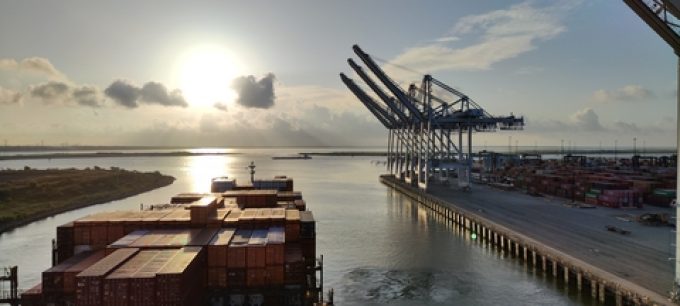Return to double-digit spot rate gains looms with new FAK hikes and surcharges
As expected after last week’s surge in spot rate levels, this week saw more modest ...
GM: GAUGING RISKGXO: NEW BOT PARTNERWMT: CAPEX IN CHECKWMT: CFO ON AUTOMATION WMT: SPOTLIGHT ON AUTOMATIONHD: PRESSURE BUILDSFWRD: REVISED EBITDA MAERSK: TESTING ONE-MONTH HIGHFDX: UP UP AND AWAYRXO: COYOTE DEAL TAILWINDDSV: NEW REFI DEALR: WEAKENING AMZN: LIFESTYLE BATTLEKNIN: EXPANDED NETWORK OF CROSS-DECK FACILITIES
GM: GAUGING RISKGXO: NEW BOT PARTNERWMT: CAPEX IN CHECKWMT: CFO ON AUTOMATION WMT: SPOTLIGHT ON AUTOMATIONHD: PRESSURE BUILDSFWRD: REVISED EBITDA MAERSK: TESTING ONE-MONTH HIGHFDX: UP UP AND AWAYRXO: COYOTE DEAL TAILWINDDSV: NEW REFI DEALR: WEAKENING AMZN: LIFESTYLE BATTLEKNIN: EXPANDED NETWORK OF CROSS-DECK FACILITIES

The increased pricing in container spot rates on the main east-west trades eased this week, with just single-digit gains.
And given their absence this week, it appears last week’s eyebrow-raising double-digit gains appear to have been propelled by carrier rate hikes on 1 June. Drewry’s World Container Index (WCI) composite rate grew 2% week on week; although it is 202% up, year on year.
The WCI’s Shanghai-Rotterdam leg also grew 2%, to reach $6,177 per 40ft – some 358% up year on year – while Xeneta’s Asia-North Europe XSI leg grew 3.3% week on week, to $5,835 per 40ft.
The WCI’s Shanghai-Genoa was up 3%, to $6,882 per 40ft.
On the transpacific, the WCI Shanghai-Los Angeles and Shanghai-New York indices both grew 1%, to $6,025 and $7,299 per 40ft, respectively. The XSI’s Asia-US west coast grew 1.5%, to $5,949 per 40ft.
The timing of rate hikes may have a correlative relationship with the percentage spot rate increases, or it may be causal – either way, current price behaviour suggests the actual supply-demand of the market lends toward slower increases, while the sharper rises are forced by carriers’ aggressive pricing.
If that’s the case, the formbook suggests sharper increases next week, which Xeneta chief analyst Peter Sand predicted to delegates at this week’s TOC Europe 24 in Rotterdam. He told them: “I’m afraid to say there will be another spot rate hike in mid-June, although it seems to us at the moment that the next hike will be less extreme than the previous one, possibly indicating a slight improvement for shippers.”
What happens thereafter will depend on how long the current demand lasts, along with the associated issues of port congestions and the Red Sea crisis, and so on. But should capacity continue to be tight and voyages remain extended, new analysis from Sea-Intelligence yesterday, which used the pandemic rate performance as a guide, predicted rates on Asia-Mediterranean could pass the $20,000 per 40ft mark.
“The easiest answer to ‘how high can rates go?’ would be to point to the maximum level seen during the pandemic,” said Sea-Intelligence chief executive Alan Murphy. “This, however, does not account for the increased round-Africa sailing distances that weren’t present during the pandemic.
“To account for the longer sailing distances, we can look at the rates in relation to the distance sailed, $-per-40ft for each nautical mile sailed,” he added.
During the height of the pandemic, this was $1.60 on Asia Mediterranean and $1.40 on Asia-North Europe, according to Sea-Intelligence data.
“While this is simply historical fact, it also sets a precedent, which is that during times of severe distress, freight rates per nautical mile can reach these very high levels,” Mr Murphy continued.
“And here we arrive at the scary scenario for shippers: if the rate paid per nautical mile reaches the same level as during the pandemic, we will see spot rates of $18,900 per 40ft from Shanghai to Rotterdam, $21,600 from Shanghai to Genoa and $2,200 per 40ft on the back-haul from Rotterdam to Shanghai.
“And this is not to say that the rates couldn’t go any higher,” he added.
Comment on this article